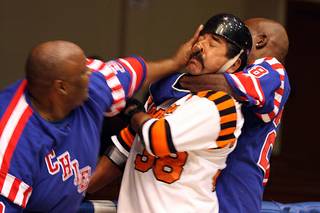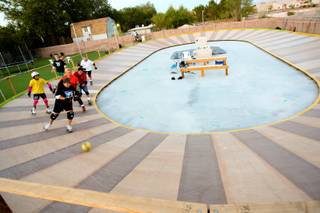
Mona Shield Payne
Dave Martinez speeds past instructor Lali O, right, as they practice whipping Saturday, June 16, 2012, at Lali O’s Roller Derby School.
Saturday, June 23, 2012 | 2 a.m.
Sun Archives
- Judge was once hell on wheels (2-19-2009)
- A painful roller derby wreck (6-16-2008)
- Not your old man’s roller derby (8-14-2007)
Old-time roller derby is back in Las Vegas, the latest stop in its effort to return the sport to its glory days — or at least help stave off extinction.
With rosters laden with aging skaters, a struggle to find and train young talent, the lack of a major television contract to bring the game to the masses and money issues, it figures to be a bumpy road ahead for the banked-track spectacle.
“I don’t do this for the money. I do it for the love of the game,” said Las Vegan Dan Ferrari, who for the past 15 years has owned and operated the nation’s last remaining professional co-ed roller derby league, the American Roller Skating Derby League, at nowhere near a profit.
“One of my assistants once informed me that I had lost $10,000 promoting a particular game, Ferrari said. “I told her I was glad I spent the money putting on that game. At roller derby games, fans get to let out their pent-up aggression by yelling at the action and they have a lot of fun. And I enjoy giving them that outlet.”
The next such outlet will be at 8 p.m. June 30 when the perennial world champion San Francisco Bombers host the Brooklyn Red Devils at Texas Station. Tickets range from $9 to $30 at the gate. Seats are cheaper if purchased in advance.
Recently, those two teams and the Los Angeles Firebirds squared off in a three-game, round-robin event at Texas Station before a respectable crowd of about 800 fans, many of whom were watching roller derby for the first time.
Ferrari, a Summerlin resident since 2010, started going with his family to roller derby games in Northern California in the late 1950s at age 2. Over the past 50 years, he has seen the game’s popularity skyrocket and plummet.
Throughout the 1960s, roller derby leagues featured games coast to coast five to seven nights a week and had large national television audiences. Stars like Ralphie Valladares, Charlie O’Connell, Joanie “Golden Girl” Weston and Ann Calvello became household names — as integral to their sport as Babe Ruth was to baseball.
“Ann Calvello once told me that roller derby is played 95 percent above the neck and 5 percent below,” Ferrari said. “I learned early on from her that as physical as the sport is, it is a game for the thinking man and woman. And to be successful at promoting it, you have to keep thinking of ways to reach out to the fan base.”
Today, Ferrari is lucky if he can put on two games a month, primarily with his Bombers as the good-guy main attraction and the other squads rotating as the villainous opponents. For now, it has to be that way because there just are not enough men and women skaters to fill the rosters of the six teams in his league.
Today’s game relies on a mixture of many veteran skaters — some in their 50s and early 60s who still have the energy to play the game — and a handful of newcomers, some of whom are children of yesterday’s stars.
“No one can say that skating is not in my family’s blood,” said Gina Valladares, the daughter of roller derby legends Ralphie Valladares and Honey Sanchez who will be on loan to the Bombers along with her son Josh for the Las Vegas game. “I wish I could skate every night like my mother and father did.”
Valladares, who has skated professionally for 22 years, said she has mixed emotions when watching her children skate.
“Of course I’m very proud of them, but I’m a little scared they might get injured,” she said. “Everyone in my family has been hurt skating in the roller derby. I hate it when people say that what we do is fake. When we fall on the track or get blocked into or over a rail, it’s very real, and sometimes we get seriously injured.”
Despite questions about the game’s legitimacy, generations of fans have loved the roller derby for its rough-and-tumble mayhem, hair-pulling catfights and bruising half-time match races that make the experience exciting up to the final whistle.
Valladares says her only regret in participating in roller derby today is that her dad is not alive to see the family’s third generation of roller derby skaters.
“It’s so sad because he would have been so pleased to watch them,” she said.
The Valladareses are not the only family of skaters in the game today. Sean Atkinson is the son of skating greats Buddy Atkinson Jr. and Drew Scott and the grandson of skating pioneers Buddy Atkinson Sr. and Bobbie Johnstone.
'Demon of the Derby: The Ann Calvello Story'
Bombers star Gwen “Skinny Minnie” Miller, who wears the great Charlie O’Connell’s No. 40 jersey, has a daughter, Jackie Holmes, who skates on the same team. Ray Robles has a son, Brian, who skates in the derby.
Other young players are in development, Ferrari said. But with so few games scheduled, the league runs the risk of losing many of them because just practicing and participating in scrimmages may not be enough to hold their interest.
Helping to create tomorrow’s stars is Las Vegan Lali O, a 10-year veteran of the banked track who was voted 2009’s Roller Derby Queen (a combination of most attractive and most valuable skater — a coveted award since the early 1960s.)
“I feel my job is to prepare the next generation for the roller derby,” said Lali, the women’s captain of the Bombers who runs a roller derby school at her Las Vegas home, teaching the game to, among others, her niece, Danette Daguiar, a local high school student who also skates for the Bombers.
“I grew up watching the roller derby on TV and pretending to play roller derby on my cul de sac,” she said. ‘I admired skaters like Judy Arnold (Raquel Welch’s body double in the movie ‘Kansas City Bomber’ who now is a minister) and the late Judy Sowinski. I consider myself a student of the game.”
Lali, a mother of three whose real last name is Outhoummountry, says that although there is young talent out there for the league to tap, she questions whether many of today’s young skaters are as dedicated to the sport as those of past generations.
“Today, a lot of the younger skaters come and go so quickly,” said Lali, who also works on the Golden Nugget switchboard to help support her family. “You have to go at the game whole-hearted. You cannot play half-hearted.”
For more than 75 years, Americans have enjoyed roller derby. Invented and diagrammed by businessman Leo Seltzer on the tablecloth of a Chicago restaurant in 1935, the first games were non-contact, marathon races on a track.
Two years later, sportswriter Damon Runyon suggested to Seltzer that the skaters be assigned to co-ed teams and that blocking be added. The addition of such controlled violence caused the game’s popularity to skyrocket.
Games are played in eight 10-minute periods, alternating between women and men. Each team uses five skaters per play, two of them designated scorers called “jammers” who earn a point for each opposing player they lap.
Roller derby found its first national audience on Nov. 29, 1948, when it debuted on CBS-TV with the New York Chiefs playing the Brooklyn Red Devils. At one point, the sport was aired four nights a week, but it was canceled in the 1950s as networks began producing their own shows and sporting events such as baseball and boxing.
In the early 1960s, two major roller derby leagues rose to prominence. The Roller Derby featured the Bombers and their championship dynasty. The Roller Games in Southern California had the equally perennial champion Los Angeles Thunderbirds. The two leagues did not square off to crown an overall champion.
Roller derby in Laughlin
In the 1960s, roller derby promoters distributed videotapes of games played in Los Angeles and San Francisco to UHF stations nationwide for broadcast. Once again the game got weekly electronic media exposure and grew in popularity.
Good luck finding valuable TV time at a reasonable price today, Ferrari says. It costs him $10,000 to $12,000 to videotape and produce a single game, and he said he has paid one independent San Francisco television station as much as $3,000 to air a single one-hour game on a Saturday afternoon.
“When you can get your games on TV, it can pay off,” Ferrari said, noting that recent crowds at San Francisco’s Kezar Pavilion grew from 700 per show to 3,000 after previously taped games were broadcast in the weeks prior to the event. Ferrari said the Las Vegas games will be videotaped for potential future TV broadcasts.
In the early 1970s, roller derby, bolstered by its weekly TV broadcasts, regularly drew large paid crowds — 19,000 to 28,000 per major game. The all-time attendance record was set in 1972 at Chicago’s Comiskey Park when 50,118 fans watched Ralphie Valladares’ L.A. T-Birds play Ann Calvello’s Midwest Pioneers.
In 1973, the Roller Derby folded amid reports that travel costs had become too high. Roller Games, however, continued into the mid-1980s, with a number of games played in Las Vegas, first at the Tropicana and later at the old Showboat.
Roller Games, despite being broadcast on ESPN, shut down and unusual versions of the sport came and went. (One promotion featured an infield alligator pit.) Flat-track women’s leagues popped up nationwide, but they are primarily a novelty.
The game’s financial struggles and unsuccessful attempts to reinvent itself over the past 30 years have done little to instill any degree of confidence for future success.
“Roller derby is at its end unless a miracle occurs,” said Ferrari, who also is a singer and acting teacher. “There are signs of hope like Texas Station agreeing to book us four times a year.
“I think it is possible for the sport to once again become successful because I truly believe there is nothing more fun and exciting than going to a roller derby game.”
Texas Station, modeled after the Lone Star State, is a AAA Three-Diamond rated hotel with 200 rooms, a casino, restaurants, bars and lounges, an entertainment showroom, a movie theater and a bowling center about six miles from the Las Vegas Strip.
It features 91,000 square feet of gaming space with more than 1,775 slots, 27 table games, a non-smoking poker room, a 500-seat bingo hall and a race and sports book.
The hotel has several dining options, from quick eateries to restaurants, including Austin's Steakhouse and Texas Star Oyster Bar. Some family-friendly features include an 18-screen movie theater and a bowling center.
South Padre provides live music weekly. The Dallas Events Center seats up to 2,000 people for concerts and other live performances.
Ed Koch is a former Sun reporter.



Join the Discussion:
Check this out for a full explanation of our conversion to the LiveFyre commenting system and instructions on how to sign up for an account.
Full comments policy